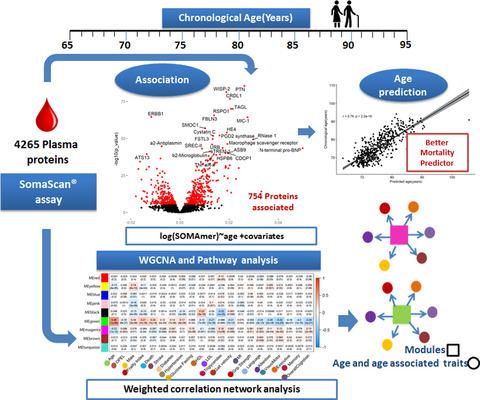当前位置:
X-MOL 学术
›
Aging Cell
›
论文详情
Our official English website, www.x-mol.net, welcomes your feedback! (Note: you will need to create a separate account there.)
Plasma proteomic profile of age, health span, and all‐cause mortality in older adults
Aging Cell ( IF 7.8 ) Pub Date : 2020-10-22 , DOI: 10.1111/acel.13250 Sanish Sathyan 1 , Emmeline Ayers 1 , Tina Gao 2 , Erica F Weiss 1 , Sofiya Milman 2, 3 , Joe Verghese 1, 2 , Nir Barzilai 2, 3
Aging Cell ( IF 7.8 ) Pub Date : 2020-10-22 , DOI: 10.1111/acel.13250 Sanish Sathyan 1 , Emmeline Ayers 1 , Tina Gao 2 , Erica F Weiss 1 , Sofiya Milman 2, 3 , Joe Verghese 1, 2 , Nir Barzilai 2, 3
Affiliation

|
Aging is a complex trait characterized by a diverse spectrum of endophenotypes. By utilizing the SomaScan® proteomic platform in 1,025 participants of the LonGenity cohort (age range: 65–95, 55.7% females), we found that 754 of 4,265 proteins were associated with chronological age. Pleiotrophin (PTN; β[SE] = 0.0262 [0.0012]; p = 3.21 × 10−86), WNT1‐inducible‐signaling pathway protein 2 (WISP‐2; β[SE] = 0.0189 [0.0009]; p = 4.60 × 10−82), chordin‐like protein 1 (CRDL1; β[SE] = 0.0203[0.0010]; p = 1.45 × 10−77), transgelin (TAGL; β[SE] = 0.0215 [0.0011]; p = 9.70 × 10−71), and R‐spondin‐1(RSPO1; β[SE] = 0.0208 [0.0011]; p = 1.09 × 10−70), were the proteins most significantly associated with age. Weighted gene co‐expression network analysis identified two of nine modules (clusters of highly correlated proteins) to be significantly associated with chronological age and demonstrated that the biology of aging overlapped with complex age‐associated diseases and other age‐related traits. The correlation between proteomic age prediction based on elastic net regression and chronological age was 0.8 (p < 2.2E−16). Pathway analysis showed that inflammatory response, organismal injury and abnormalities, cell and organismal survival, and death pathways were associated with aging. The present study made novel associations between a number of proteins and aging, constructed a proteomic age model that predicted mortality, and suggested possible proteomic signatures possessed by a cohort enriched for familial exceptional longevity.
中文翻译:

老年人年龄、健康跨度和全因死亡率的血浆蛋白质组学特征
衰老是一种复杂的特征,其特征在于内表型的多样性。通过在 LonGenity 队列的 1,025 名参与者(年龄范围:65-95 岁,55.7% 女性)中使用 SomaScan ®蛋白质组学平台,我们发现 4,265 种蛋白质中有 754 种与实际年龄相关。多效蛋白(PTN;β[SE] = 0.0262 [0.0012];p = 3.21 × 10 -86),WNT1 诱导信号通路蛋白 2(WISP-2;β[SE] = 0.0189 [0.0009];p = 4.6)10 -82 ), chordin 样蛋白 1 (CRDL1; β[SE] = 0.0203[0.0010]; p = 1.45 × 10 -77 ), transgelin (TAGL; β[SE] = 0.0215 [0.0011]; p × 9.7. 10 -71) 和 R-spondin-1(RSPO1; β[SE] = 0.0208 [0.0011]; p = 1.09 × 10 -70 ),是与年龄最显着相关的蛋白质。加权基因共表达网络分析确定了九个模块中的两个(高度相关的蛋白质簇)与实际年龄显着相关,并证明衰老生物学与复杂的年龄相关疾病和其他与年龄相关的特征重叠。基于弹性净回归的蛋白质组年龄预测与实足年龄的相关性为0.8(p < 2.2E-16)。通路分析表明炎症反应、机体损伤和异常、细胞和机体存活以及死亡通路与衰老有关。本研究在许多蛋白质与衰老之间建立了新的关联,构建了一个预测死亡率的蛋白质组学年龄模型,并提出了一个因家族异常长寿而富集的队列可能具有的蛋白质组学特征。
更新日期:2020-11-23
中文翻译:

老年人年龄、健康跨度和全因死亡率的血浆蛋白质组学特征
衰老是一种复杂的特征,其特征在于内表型的多样性。通过在 LonGenity 队列的 1,025 名参与者(年龄范围:65-95 岁,55.7% 女性)中使用 SomaScan ®蛋白质组学平台,我们发现 4,265 种蛋白质中有 754 种与实际年龄相关。多效蛋白(PTN;β[SE] = 0.0262 [0.0012];p = 3.21 × 10 -86),WNT1 诱导信号通路蛋白 2(WISP-2;β[SE] = 0.0189 [0.0009];p = 4.6)10 -82 ), chordin 样蛋白 1 (CRDL1; β[SE] = 0.0203[0.0010]; p = 1.45 × 10 -77 ), transgelin (TAGL; β[SE] = 0.0215 [0.0011]; p × 9.7. 10 -71) 和 R-spondin-1(RSPO1; β[SE] = 0.0208 [0.0011]; p = 1.09 × 10 -70 ),是与年龄最显着相关的蛋白质。加权基因共表达网络分析确定了九个模块中的两个(高度相关的蛋白质簇)与实际年龄显着相关,并证明衰老生物学与复杂的年龄相关疾病和其他与年龄相关的特征重叠。基于弹性净回归的蛋白质组年龄预测与实足年龄的相关性为0.8(p < 2.2E-16)。通路分析表明炎症反应、机体损伤和异常、细胞和机体存活以及死亡通路与衰老有关。本研究在许多蛋白质与衰老之间建立了新的关联,构建了一个预测死亡率的蛋白质组学年龄模型,并提出了一个因家族异常长寿而富集的队列可能具有的蛋白质组学特征。



























 京公网安备 11010802027423号
京公网安备 11010802027423号